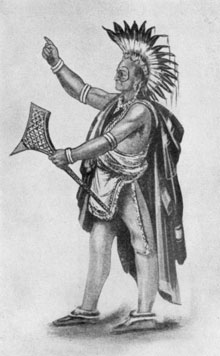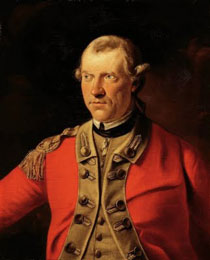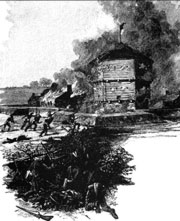Small Planet Communications, Inc. + 15 Union Street, Lawrence, MA 01840 + (978) 794-2201 + Contact








Read a biography of Chief Pontiac.
The Treaty of Paris, which was signed in 1763, ended the French and Indian War. Unlike the French army, the Native Americans of the St. Lawrence and Ohio river valleys had not been decisively defeated in the war. The Treaty of Paris might have proclaimed them subjects of King George III but, in reality, they were securely in possession of the lands west of the Appalachians.
French priests and traders had remained friendly with American Indians after the war. The American Indians had grown accustomed to receiving gifts of European goods from the now vanquished French: blankets, iron tools and vessels, firearms, and liquor, for example. The English attitude, however, was not nearly as conciliatory as the French and, after the signing of the peace treaty, General Sir Jeffrey Amherst, a British commander, announced that the English would no longer be providing gifts to the American Indians. They also increased the resentment of the western tribes by building forts and allowing settlement on lands that American Indians considered their own.
Learn more about the Ottawa Tribe.
Learn more at Conspiracy of Pontiac.
This site includes notes on some of
the forts attacked as well as some
important figures of the conflict.
Find out more about Pontiac's
Rebellion. This site includes a map
that shows several of the forts.
In response, several tribes united behind a resourceful Ottawa chief named Pontiac, who organized what settlers called a conspiracy (another name for Pontiac's Rebellion is Pontiac's Conspiracy) in an attempt to drive settlers back east across the Appalachians. At an American Indian gathering near Detroit in April 1763, Pontiac called for the extermination of English settlers from Native American lands.
Pontiac realized that attacking one English fort at a time was futile, since the English would call on nearby garrisons for reinforcements. Pontiac's plan was to attack a number of British outposts simultaneously. These forts were to be attacked at once, destroying the English foothold in the west.
Learn more about
Colonial Fort Michilimackinac.
The Delaware, Seneca, Chippewa, and Shawnee tribes seized the British outposts at Sandusky on May 16, Presque Isle on June 1, and Michilimackinac in early June. The Potawatomi, who were also aligned with Pontiac, captured Fort St. Joseph at present-day Niles, Michigan, on May 25. Fort Miami (present-day Fort Wayne, Indiana) fell on May 27, followed by Fort Ouiatenon on June 1.
In a little over a month, Pontiac's forces had overrun most of the British forts in the region extending from the Pennsylvania frontier to Lake Superior. By mid-1763, Detroit was the only British post west of Niagara, New York, that had not fallen to American Indian attack. The well-organized American Indian offensive slowed in the summer of 1763, however, when Pontiac failed to capture this major British post.

Learn more about Henry Gladwin,
who defended Fort Detroit.
Learn more about Ottawa Chief
Pontiac & the Attack on Detroit.
Find out more about Fort Detroit.
Pontiac himself directed the attack on the fort at Detroit. The plan was for Pontiac and some of his chiefs to access the fort by requesting a council with the commandant, and then open a surprise attack. Major Henry Gladwin, the commandant, learned of the plan beforehand and squelched it. Despite the foiled plot, Pontiac, along with his Ottawas, the Wyandots (Hurons), Potawatomis, and Ojibwas, stormed Fort Detroit on May 10.
Even though they were vastly outnumbered, the British held on to the fort at Detroit. The garrison was relieved by reinforcements and supplies from Niagara in the summer. Captain James Dalyell, who was General Amherst's assistant, arrived with reinforcements and supplies and succeeded in getting into the fort. Dalyell proposed an attack on Pontiac's warriors, who were about a mile up the river. Gladwin objected, but Dalyell persisted, and with more than two hundred men, he moved through the darkness in the early hours of the morning on July 31, hoping to surprise Pontiac's camp. The plan backfired, as Pontiac's warriors instead caught Dalyell's group by surprise at Parent's Creek. Dalyell and about sixty of his men were killed. Both the creek and the battle became known as Bloody Run, and Pontiac continued besieging Fort Detroit until November, at which time he withdrew, unsuccessful in his capturing of the garrison.

Artist rendition of Pontiac's
warriors attacking a British fort.
View this video about The Battle
of Bushy Run.
Learn more about the
History of Bushy Run Battlefield.
Meanwhile, Fort Pitt, warned of the uprising by a messenger sent by Gladwin, held the attackers at bay until Colonel Henry Bouquet arrived in August. On the way to the fort, Colonel Bouquet and his men engaged the American Indians in an intense battle at Bushy Run. Bouquet lost about one-fourth of his command and all of his horses, but he drove the assailants away and entered Fort Pitt with those who survived.
In the spring of 1764, the English sent out two armies as part of an offensive campaign; Colonel Bouquet led one group into Ohio and Colonel John Bradstreet led the other group to the Great Lakes. Bradstreet made treaties with the American Indians that were met with disapproval by General Thomas Gage, who had succeeded Sir Jeffrey Amherst as commander in chief. Colonel Bradstreet eventually returned home to Oswego, New York, with little to show for his effort. Bouquet, however, was able to get the American Indians in Ohio to release their prisoners and end the fighting.
Pontiac, realizing that he now had little chance to succeed in the rebellion, eventually completed a treaty in 1766 with Sir William Johnson. As one of the conditions of the treaty, Pontiac was considered not guilty of any wrongdoing and was allowed to return home to his family. In 1769, Pontiac was murdered by an American Indian who may have been paid to do it by an English trader.
In order to maintain peace with the American Indians, the British closed the west to European settlement. They also began to tax the colonists to pay for the forts in the west. These acts would be cited by rebellious colonists as critical issues as 1776 approached.
Pontiac's Rebellion | Bibliography
- Bushy Run Battlefield. "History of Bushy Run Battlefield." Accessed 6/19/19. http://bushyrunbattlefield.com/history/
- Bushy Run Battlefield. "The Battle of Bushy Run" (video) Accessed 6/19/19. https://bushyrunbattlefield.com/
- Encyclopedia Britannica. "Thomas Gage." Accessed 6/19/19. https://www.britannica.com/biography/Thomas-Gage
- Ohio History Central. "Pontiac." Accessed 6/19/19. http://www.ohiohistorycentral.org/w/Pontiac
- History Detroit. "Detroit Places: Fort Detroit, British Rule, 1760–1796." Accessed 6/19/19. http://historydetroit.com/places/fort_british.php
- History Detroit. "People of Detroit: Henry Gladwin." Accessed 6/19/19. http://historydetroit.com/people/henry_gladwin.php
- History Detroit. "People of Detroit: Ottawa Chief Pontiac." Accessed 6/19/19. http://historydetroit.com/people/pontiac.php
- History of the USA. Converted from Henry William Elson's History of the United States of America. The MacMillan Company, NY, 1904. "Conspiracy of Pontiac." Accessed 6/19/19. http://www.usahistory.info/French-Indian-War/Pontiac.html
- Blupete. Landry, Peter. "John Bradstreet (c.1711–74)." Accessed 6/19/19. http://www.blupete.com/Hist/BiosNS/1700-63/Bradstreet.htm
- The Mighty Mac. "Colonial Fort Michilimackinac." Keith Stokes. Accessed 6/19/19. http://www.mightymac.org/michilimackinac.htm
- Native Languages of the Americas: Ottawa (Odawa, Odaawa). “Ottawa Indians Fact Sheet.” Accessed 6/19/19. http://www.native-languages.org/ottawa.htm
- Supreme Court of Ohio. "Pontiac (c. 1714–April 20, 1769)." Accessed 6/19/19. http://www.supremecourt.ohio.gov/MJC/places/pontiac.asp
- U-S-History.com. "Pontiac's Rebellion." Accessed 6/19/19. http://www.u-s-history.com/pages/h598.html
Pontiac's Rebellion | Image Credits
- Pontiac, the Red Napoleon (from a painting) | Artist: Unknown; from Sabin, Edwin L. Boys' Book of Indian Warriors. Philadelphia: George W. Jacobs & Company, 1918. (p. 72) The Project Gutenberg
- Henry Gladwin | Artist: John Hall, 18th Century; Detroit Institute of Arts
- Pontiac's Rebellion | Artist: Unknown; from Smith, Carter, Ed. The Native American Experience. Facts on File, Inc., 1991. California State University, Long Beach courtesy of the Library of Congress
- General Thomas Gage | Artist: Unknown; ThoughtCo. American History photograph courtesy of the National Archives & Records Administration
© 2020 Small Planet Communications, Inc. + Terms/Conditions + 15 Union Street, Lawrence, MA 01840 + (978) 794-2201 + planet@smplanet.com



